It remains the biggest killer in Wales and has enormous ramifications for the NHS, crime, and even those who don’t directly indulge in it Smoking has far-reaching consequences for so many people(Image: Cardiff and Vale University Health Board/WalesOnline/Rob Browne)
Smoking has far-reaching consequences for so many people(Image: Cardiff and Vale University Health Board/WalesOnline/Rob Browne)
Smoking rates have reached historic lows in the UK but in 2025 tobacco remains the “leading cause of preventable death in Wales”. Yet packets of cigarettes and vapes sit on shop counters every day, perfectly legal and easy to buy. Behind the normality are stories of grief, addiction, and regret.
As the wife of one man diagnosed with lung cancer told us: “It was horrific, it was a nightmare, and an emotional rollercoaster.”
While smoking rates continue to fall, the rise of vaping has blurred the lines between helping smokers quit and leading people to a new addiction. For the biggest stories in Wales first sign up to our daily newsletter.
The phenomenon sees the highly addictive drug nicotine now being sold under the guise of fruity flavours and colourful packaging.
These vapes are increasingly the choice of children and teenagers who have never before even picked up a cigarette.
“It’s worrying me to death,” another woman told us. “[My grandkids] are 17 and 18 and they are both vaping but they never ever smoked… It’s so easy for them to go into the shop and get them and there’s nothing I can do about it.”
While the health effects of smoking are clear we are likely still decades away from knowing the impact of vapes on developing brains and lungs.
Both the tobacco and vape industries remain legal and profitable, albeit controversial. They raise tough questions about choice, health, inequality, and the price people pay.
Over recent months WalesOnline has spoken to smokers, doctors and Trading Standards about the reality of nicotine use – how it hooks people in, how vaping is changing habits, and where the law struggles to keep up.
Is it really that bad?
In 1948 the highest level of smoking tobacco among men in Britain was recorded at 82% while women who smoked peaked in the mid-1960s at 45%, according to tobacco industry surveys.
That is hard to imagine today with fewer people than ever before smoking tobacco. Ever since government surveys on smoking began in 1974 the rate of smoking has declined.
According to the latest UK figures from smoking campaigners Ash – published in 2025 – 11.9% of adults smoked in 2023.
This includes 13.7% of men and 10.1% of women. The rate of smoking among adults in Wales sat just above this average at 12.6%. In England it was 11.6% while the figure for Scotland was 13.5% and in Northern Ireland 13.3%.
Between 2011 and 2023 the largest fall in smoking prevalence had been among 18 to 34-year-olds. However those aged 25 to 34 had the highest proportion of current smokers at 14.0%.
Despite this huge fall Ash shared in its 2025 fact sheet some alarming statistics from the Global Burden Study of Disease from 2021 with one particularly eye-catching reality: smoking remained the leading risk factor for death in the UK.
This was followed by high body mass index, alcohol use, low physical activity and drug use.
In 2025 the Welsh Government confirmed this trend had continued, stating in its Preventing Ill Health Written Statement: “Smoking and obesity are the two main causes of premature death and preventable illness in Wales.”
Similarly an analysis by Public Health Wales published in 2024 showed that 10% of deaths in Wales were due to smoking.
The analysis also showed that on average more than 17,000 hospital admissions each year in Wales were attributable to smoking.
Ash Cymru estimates that smoking-related illnesses cost NHS Wales £300m annually.
Around half of all lifelong smokers will die prematurely and, on average, lifelong
cigarette smokers die 10 years younger than non-smokers, according to a British Medical Journal study.
The habit is the biggest cause of cancer in the world and it ranks among the top causes of cardiovascular disease.
More deaths can be attributed to complications associated with chronic obstructive pulmonary disease (COPD). According to the NHS around nine in 10 cases of COPD are caused by smoking.
So how can smoking still be responsible for so much harm when so few people light up today? Public health experts say the numbers reflect smoking’s legacy. Many of today’s deaths are the result of exposure that began decades ago.
Professor Tracy Daszkiewicz, the executive director of public health at Aneurin Bevan University Health Board, told WalesOnline: “We will see people develop comorbidities around 50 and 55.”
She said that these illnesses are particularly prevalent in deprived areas. She said: “Smoking is particularly harmful in terms of the impact it has on the body.
“As well as cancers we will see cardiovascular disease, heart attacks, strokes, aches. Circulatory and respiratory illness are huge factors in people who smoke.
“The impact of smoking and the prevalence of smoking is a major health inequality so we will see the impact and the prevalence in areas of higher deprivation.”
According to the 2021 census Wales had 54.1% of households deprived in one or more dimensions.
More than a quarter (28.9%) of all adult smokers were living in the two most deprived deciles compared with 9.3% living in the two least deprived deciles.
Quitting saved my life and £23,000
In March 2023 Denise Jenkins from Splott in Cardiff stopped smoking once and for all.
After getting hooked as a “naughty schoolgirl” aged 15 she had smoked between 40 and 60 cigarettes a day for 50 years.
Now, in October 2025, she is almost 950 days smoke-free.
In that time she said her life has completely transformed; she feels healthier than ever before both in her body and her bank balance.
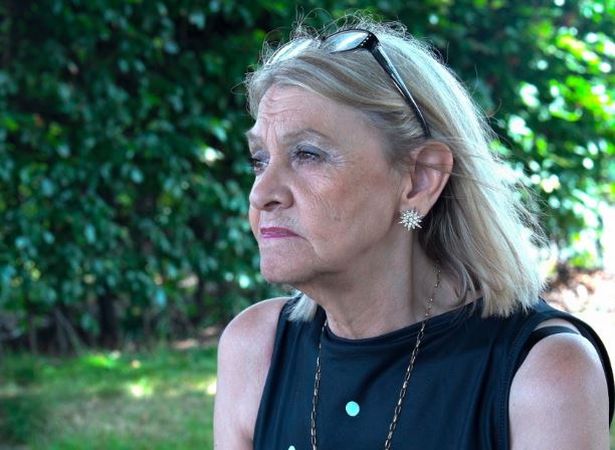 Denise Jenkins(Image: Cardiff and Vale University Health Board)
Denise Jenkins(Image: Cardiff and Vale University Health Board)
“I have not had one puff since I packed it in. I feel like a different person,” she told WalesOnline.
“I’ve put away £24 a day ever since and I went and bought a new car with it. I worked out roughly what I was paying for 40 cigarettes a day – but they’re probably even more expensive now.”
Turning to her NHS Smokefree app on her phone, which offers daily support and tracking, the 68-year-old said: “Are you ready for this? It says I’ve saved £22,656.”
Speaking to Denise now she sounds confident and full of life but she said this is a far cry from how she felt just a few years ago.
A diagnosis of COPD and rheumatoid arthritis – both of which are strongly associated with smoking – had left her almost bedridden.
“I was at rock bottom,” she said. “I felt like if [my body] didn’t give up I would have had to give up because there would have been nothing else worth living for. It was awful.
“I think I got to my worst because my pain was so bad. In my head the cigarettes were helping but actually they were making it worse.
“I was restricted to the house and bored so I was just smoking more and more and more and more. I was probably smoking up to 80 towards the end.
“I put on lots of weight, which I’ve lost again now. My hair deteriorated like rats’ tails, my skin deteriorated. I almost felt like I didn’t go where non-smokers were in case they detected how badly I smelt of smoke.”
Denise said she felt so unwell and breathless that all sorts of scenarios ran through her head.
“At my worst I thought it was something that nobody had detected because we all fear lung cancer and I thought it might have been that – but I had so many tests because I often had chest infections.”
Denise said her final straw came during a COPD appointment when she felt like smoking was killing her.
She said: “In my doctors’ there are stairs and I was struggling to get up the stairs. I said to my nurse one day: ‘This smoking is killing me’.
“That day I had to blow into the pump and I didn’t have the breath to blow into it.”
During that appointment Denise said her nurse referred her to Wales’ stop smoking service Help Me Quit. Through that she was given tailored one-to-one support from her adviser, Cathy Fisher, and struck up an instant rapport.
“I had to hit rock bottom,” she said. “I didn’t want to quit smoking. I met Cathy and we just clicked. When she asked me why I wanted to quit smoking I clearly remember saying: ‘Because it’s killing me.’
“She told me that’s a positive because I can only go upwards from here. I have not had one puff of a cigarette since that day.”
‘As addictive as opioids and cocaine’
Denise said she is now “repulsed” by the smell of cigarettes but such is the addictive power of nicotine that even after all the progress she has made she craves having one. “I could kill for a cigarette,” she said. “Sometimes I have bad days and I reach for a small patch or spray.”
According to the Centre for Addiction and Mental Health inhaled smoke delivers nicotine to the brain within 20 seconds, which makes it very addictive and comparable to opioids and cocaine.
This rings true for another former smoker who told WalesOnline how she even struggled to give up smoking after she suffered a heart attack.
The woman in her 80s who does not wish to be named said: “I started smoking in 1961 as I was finishing school and went on to have a career in nursing. In those days most people smoked. Doctors smoked, nurses smoked.
“I stopped in 2000 following a heart attack and it was really hard for about four months. I used to sit at the bottom of the stairs with my fist in my mouth because I was so desperate for a cig.”
 Professor Tracy Daszkiewicz(Image: Aneurin Bevan University Health Board)
Professor Tracy Daszkiewicz(Image: Aneurin Bevan University Health Board)
As Prof Daszkiewicz explained: “We talk about choices around these addictions like smoking and alcohol but it’s not a choice – it’s an addiction and addiction is an illness. And there isn’t any choice in that.
“There is the physical addiction of nicotine and the habitual addiction – hand to mouth action – as well. It’s a major challenge in terms of people recognising that it isn’t easy to quit and it’s also not a fault.
“There is a lot of misinformation around smoking and quitting. People underestimate how difficult that is.”
Lung cancer symptoms are not what you think
Another misconception is that lung cancer symptoms are always obvious and easy to spot and that you will notice a clear change in your breathing if anything were to be amiss.
Phil Pickens from Treherbert is lucky to be living proof that this is not the case and he is now using his terrifying ordeal to educate others about the disease.
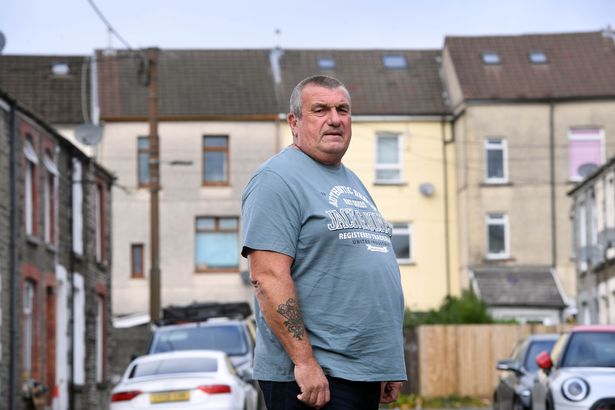 Phil Pickens(Image: WalesOnline/Rob Browne)
Phil Pickens(Image: WalesOnline/Rob Browne)
“I started smoking at 11 years old and I smoked for 52 years,” he said. “I had no symptoms at all. I had always had a cough because I was a heavy smoker but nothing had changed or gotten worse.”
But Phil’s life completely changed when he got a call in autumn 2023 to say he was part of a lung screening pilot and was eligible for a scan.
“They were contacting people in Wales who were over 60 and smoked,” he said. “I had a phone call, I answered a few questions, and they put me down for a scan.
“I went down in October and they found a tumour on my lung.”
Phil’s wife Wendy described the moment she found out about her husband’s diagnosis.
”It was horrific. It was a nightmare and an emotional rollercoaster,” she said. “When he found out he had been working in Thornton so he had to drive all the way back.
“When he walked into the house he was absolutely grey. I knew something was wrong. It was out of the blue and we didn’t expect it at all.”
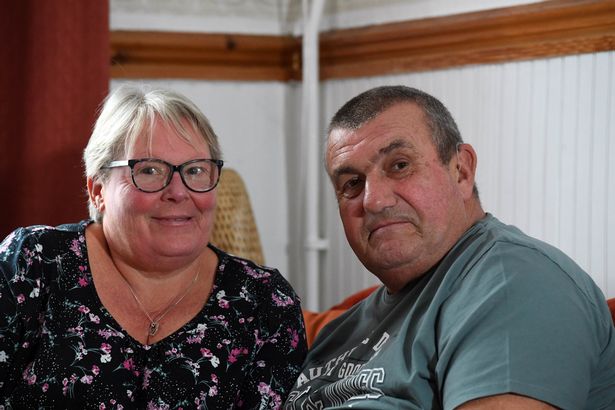 Phil and Wendy(Image: WalesOnline/Rob Browne)
Phil and Wendy(Image: WalesOnline/Rob Browne)
By December Phil, then 63, had been operated on, which resulted in one third of his lung being removed.
“They removed the tumour and I had three months’ worth of chemo at Velindre in Cardiff. I’m in remission now and I have a scan every six months.”
Phil said he was told that if he had gone even a few months longer without treatment his cancer would have been incurable, which is exactly what would have happened if it wasn’t for that phone call. Putting it simply he said: “It saved my life.”
Tenovus Cancer Care charity was at the forefront of campaigning for a targeted lung cancer screening programme, particularly since the UK Lung Screening Committee made its official recommendation for each UK nation to implement one back in June 2022.
In June 2025 Jeremy Miles MS, cabinet secretary for health and social care, announced the Welsh Government will introduce a national lung cancer screening programme in Wales targeted towards those at greatest risk.
It is anticipated the first people will be invited to take part in screening in 2027.
Someone else who welcomes the move is Matt Brouns, a consultant in respiratory medicine at Aneurin Bevan University Health Board.
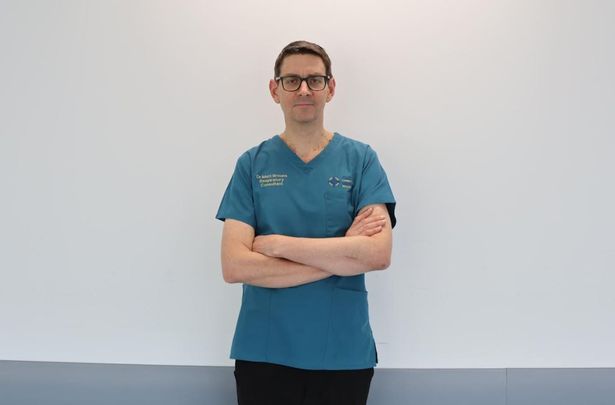 Consultant Matt Brouns(Image: Aneurin Bevan University Health Board)
Consultant Matt Brouns(Image: Aneurin Bevan University Health Board)
He said Phil’s experience is one he sees regularly in hospitals.
He told WalesOnline: “Unfortunately we see a lot of people who develop symptoms from lung cancer and by the time they develop symptoms they unfortunately have incurable disease.
“The best way we are able to offer curative treatment is for those where it’s found by chance because they have an X-ray or scan for another reason.
“In Aneurin Bevan it is less than one in five people who we can offer curative treatment to. The vast majority of people have incurable cancer by the time they present to us.”
He explained why this is. “You have a lot of space for things to grow in your chest without them necessarily causing issues.
“When you exercise and max out you have about 20% extra capacity in your lungs and only elite athletes start to encroach on that so there is always extra room. It takes a lot before you start to develop symptoms.”
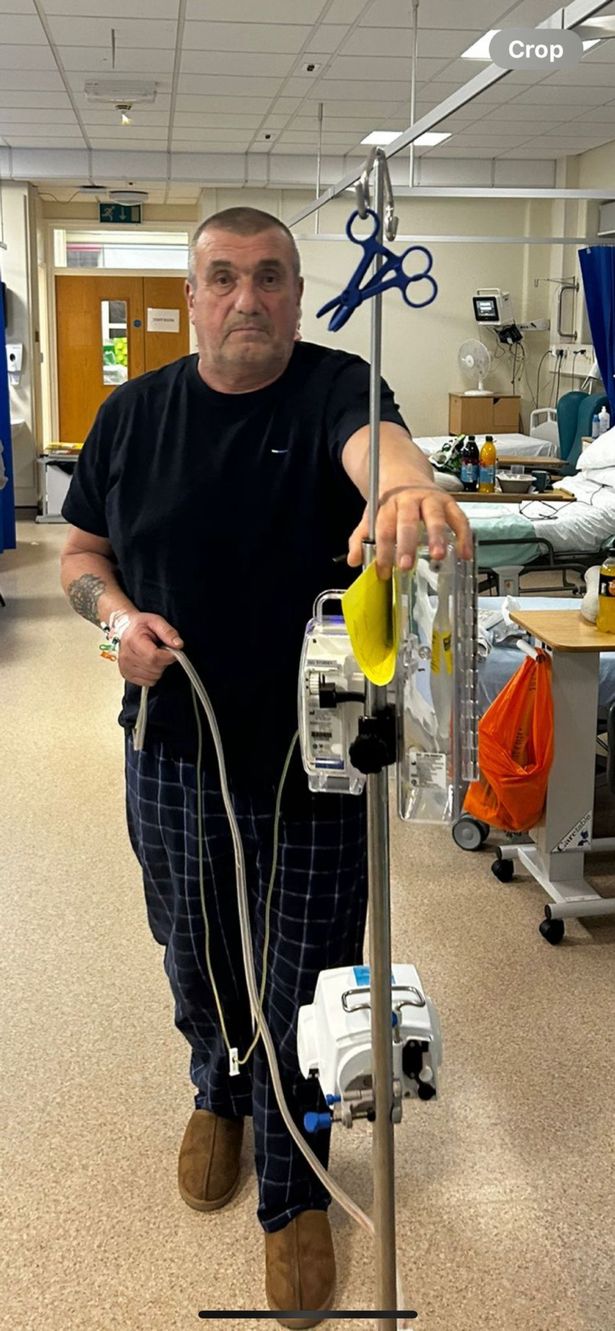 Phil Pickens at hospital(Image: Wendy Pickens)
Phil Pickens at hospital(Image: Wendy Pickens)
Describing the kind of patients he usually sees he said: “The typical person is someone in their 70s who has been a heavy smoker – not necessarily still smoking – and who also has other health problems as a consequence of smoking such as heart disease or COPD.
“We are seeing more and more women. You can get lung cancer in non-smokers but it’s less common.”
But it isn’t just lungs affected – or just the over-50s
Darren Daniel from Ammanford was 11 when he picked up his first cigarettes and started smoking casually with friends before he started full-time at around 15 years old.
His addiction lasted more than two decades until he was left with no choice but to quit aged 36 in 2017.
The now 45-year-old had developed a number of worrying symptoms which were caused by a serious condition likely linked to smoking.
He told WalesOnline: “I was on about 30 a day at the time and I had some serious issues including some blurred vision and slurred speech.
“I rang NHS Direct and they told me to go down and have some tests. I was diagnosed with kidney disease, also called neurophotic syndrome. It is a complication that can come from smoking.
“That led to something more serious: focal segmental glomerulosclerosis (FSGS) – a rare form of kidney disease.
“It means the filters in the kidneys are scarred. In the long term I’m looking at going into kidney failure. I’m going to need dialysis in the future – it’s a 90% chance.
“For some people it’s brought on very quickly. It could be next year or I could be 70 but it’s likely at some point.”
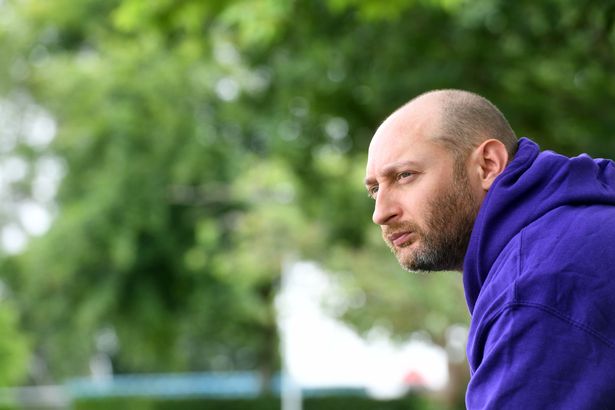 Darren Daniel(Image: WalesOnline/Rob Browne)
Darren Daniel(Image: WalesOnline/Rob Browne)
Darren said he wants smokers to be aware that tobacco and nicotine can exacerbate any underlying health issues they have, including ones they are not aware of.
Tests revealed he has high blood pressure and was born with a condition named familial hypercholesterolemia – a genetic condition that causes high cholesterol from birth, putting those with the condition at risk of early heart disease.
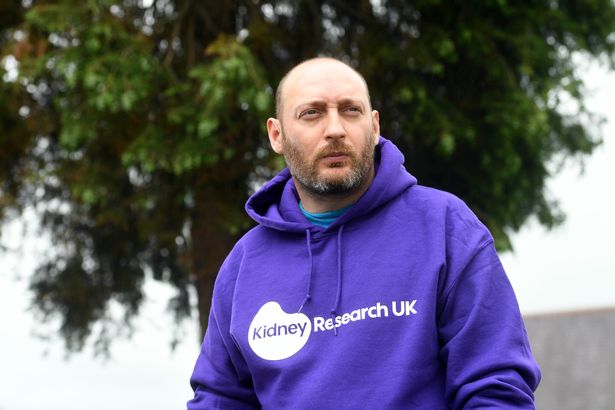 The dad found out he has kidney disease and may need dialysis in the future(Image: WalesOnline/Rob Browne)
The dad found out he has kidney disease and may need dialysis in the future(Image: WalesOnline/Rob Browne)
He said these are also factors which likely contributed towards his kidney disease but that smoking made the complication more likely, or at least brought it on earlier.
He said this has pretty much been proven by the good medical results he has seen since he stopped smoking. “I’ve stopped proteinuria which is a very positive sign but I’m also heavily medicated and looking after my blood pressure and cholesterol.”
Reflecting on his smoking addiction he said: “I feel like smoking has taken years of my life away from me to be honest. It has contributed to my kidney disease.
“It could be that I was prone to it but as a young man in my 30s and having kidney disease it makes me wonder what would have happened if I didn’t smoke. I feel like it has taken away some part of my life.”
Coming from a family of smokers Darren said his biggest achievement to come from quitting is that his children will hopefully never follow in his footsteps.
He said: “I feel quite positively about it because my son has never seen me with a cigarette or a vape in my mouth, I haven’t passed this habit on to my children.”
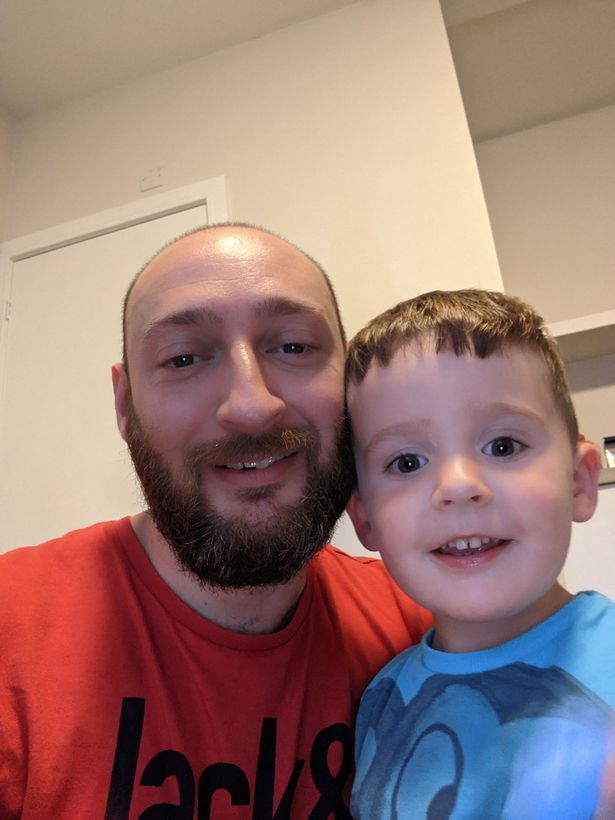 Darren with his son (Image: WalesOnline)
Darren with his son (Image: WalesOnline)
Dr Brouns explained how smoking affects the entire body. He said: “You can imagine that if you inhale all the 600-plus chemicals in tobacco they will cause problems within your lungs but they also cause inflammation and irritation within your blood vessels.
“The chemicals get into your blood and they cause narrowing of the blood vessels throughout your body and so consequently they can cause problems throughout your body because your blood vessels go everywhere.
“They also can damage the DNA in your cells which puts people at risk of developing cancers – and that isn’t only in the areas of the body that are directly exposed like your throat and your lungs. A huge cohort of possible diseases.”
The effects don’t just stop with the smokers either
Dr Brouns and Prof Daszkiewicz each raised serious concerns about passive smoking and the lesser-spoken-about “third-hand” smoking – something that is very harmful but underreported and misunderstood.
Passive smoking, also known as second-hand smoke, is the involuntary inhalation of smoke from someone else’s cigarette, cigar, or pipe.
People who breathe in second-hand smoke regularly are more likely to get the same diseases as smokers, including lung cancer and heart disease, while pregnant women exposed to it are prone to premature birth. Their babies are more at risk of low birthweight and sudden infant death.
Third-hand smoking is the toxic residue of smoking that lingers on surfaces like furniture, walls, clothes, and hair long after a cigarette has been put out.
It contains harmful chemicals such as nicotine and carcinogens like formaldehyde, which can be absorbed through skin contact, ingestion, or by being re-released into the air.
Dr Brouns said: “You do see people with COPD who say they’ve never smoked and then you look for other possible causes and the only thing you find is that they grew up in a pub, or that their parents both smoked when they were young, so you do see it.
“And then there’s third-hand smoke. If you go outside and smoke so you’re not around the kids, but then you come in the house and it’s on your person, that has still been shown to lead to an increased risk of wheeziness in children.”
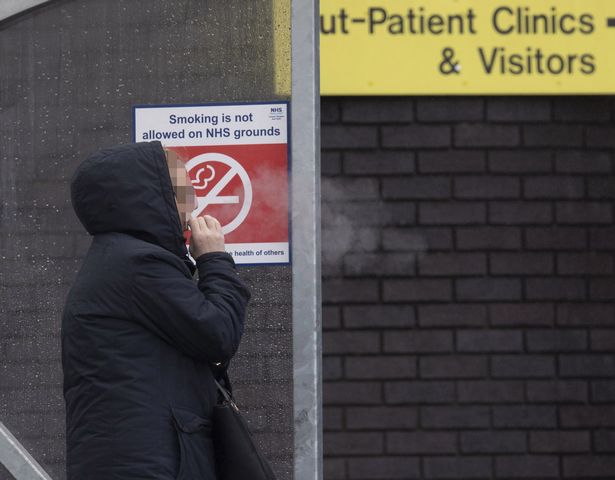 Smokers are regularly seen outside hospitals(Image: DAILY RECORD)
Smokers are regularly seen outside hospitals(Image: DAILY RECORD)
Prof Daszkiewicz added: “Passive smoking kills and the impact it has on children is immense. Famously [entertainer] Roy Castle died because of passive smoking from playing the trumpet in pubs where people smoked.
“Even if you are walking behind someone in the street you’re getting the downwind effect of their smoking because they are outside and they can still do that .
“There are still some pub gardens where you choose to sit outside and you are then sat with the smokers who are so you are still getting access to passive smoke.
“The impact of passive smoking is very, very real.”
Prof Daszkiewicz then addressed the elephant in the room: that smokers very commonly smoke outside our hospitals.
She said: “There is a huge campaign at the moment to challenge smoking outside our hospitals [in Aneurin Bevan health board area].
“Hospital sites by law are smoke-free but we still have people – patients, staff, and visitors – standing on hospital grounds smoking.
“They just don’t realise the impact that that’s having. They are standing outside hospitals and the rooms above them are wards with poorly patients inside.”
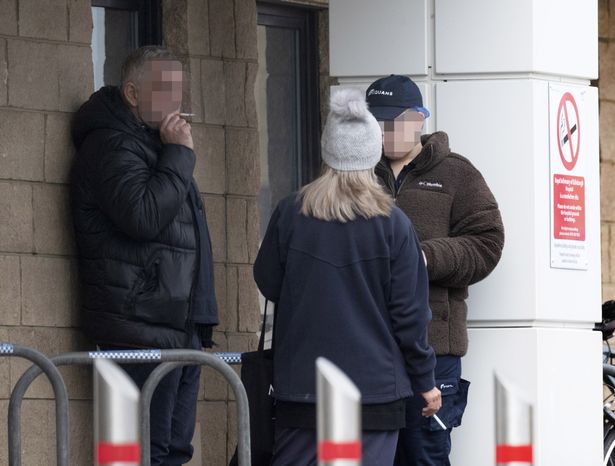 Prof Daszkiewicz said people don’t realise the impact of smoking outside hospitals(Image: DAILY RECORD)
Prof Daszkiewicz said people don’t realise the impact of smoking outside hospitals(Image: DAILY RECORD)
Dr Brouns is the face of the hard-hitting campaign, which shares the striking message: “If you smoke, I smoke. Stop now.”
Despite legislation introduced in 2021 making it illegal to smoke on hospital grounds in Wales the problem remains widespread.
In the 12 months up to March 2025 a total of 85 complaints were made about people smoking on Aneurin Bevan sites with 70% of these incidents taking place at The Grange University Hospital alone.
This issue is not isolated to the health board area or indeed Wales with smokers commonly seen outside hospitals across the UK.
To vape or not to vape
“I think my grandkids do it because everyone else their age is doing it.
“They’re 17 and 18 and they are both vaping but they never ever smoked – and they used to tell me off for smoking which was one of my reasons for quitting.
“It’s the ‘in thing’ to do in my opinion. My granddaughter asked me to get her a vape in the shop, strawberry frost flavour or something, and I told her: ‘No’. But she’s 18 now and she can get them herself.
“It’s so easy for them to go into the shop and get them and there’s nothing I can do about it.”
These words of a “worried sick” grandmother from Cardiff echo the concerns of many families across Wales and the UK.
According to data published in 2024 by the School Health Research Network almost one in six year 11 students in Wales (15.9%) are regularly using vapes.
More than 45% of students in year 11 say they have tried a vape.
Meanwhile just 5.5% of students in year 11 now regularly smoke tobacco – down from 7.5% in 2021.
A little less than 3% (2.7%) of students in years seven to 11 smoke tobacco regularly. The majority of these also vape.
But what impact does vaping have on our health – and in particular the health of children and teenagers?
The answer is that experts don’t really know.
 Disposable vapes previously for sale in a shop. They were banned in June 2025(Image: PA)
Disposable vapes previously for sale in a shop. They were banned in June 2025(Image: PA)
Although vapes do not contain the hundreds of toxic chemicals found in smoking they do contain nicotine. Although nicotine is highly addictive it is relatively harmless to most people, according to the NHS.
However it is not risk-free and according to the Royal Society for Public Health it can cause some issues such as increased blood pressure.
Prof Daszkiewicz said the current advice is simple: if you don’t smoke then don’t start vaping. If you do smoke vaping is an accessible short-term aid to help you quit.
She said: “E-cigarettes were introduced as a smoking replacement therapy to help people quit smoking.
“They are so widely available now but it was meant to be done as part of a supported programme where you would reduce your nicotine gradually through your vape until you got to the point where you could quit.
“Some people still absolutely use them in this way but for others vaping becomes a long-term habit and there are challenges within that.
“Whereas smoking cigarettes has a start, a middle, and an end a vape doesn’t so you could possibly puff on a vape almost continuously.
“We have seen a shift so that vaping has become very, very prevalent among young people and the impact of nicotine on your brain and brain development is really important to understand.
“When we’ve spoken to some young people they think they are just inhaling steam – people don’t realise there is an addictive substance in there. Then other young people are incredibly well-informed and know what they are vaping.”
Dr Brouns said it is very rare he comes across patients in hospitals because of vaping.
He said: “Even though there are lots of unknowns it is accepted that vaping has to be safer. So if you’re smoking it’s a good way of quitting – but if you aren’t smoking don’t start either.”
The illegal market in Wales
Not many people associate crime with smoking as they do with alcohol and drugs.
Cigarettes and vapes are legal and they do not change behaviour in a dramatic way.
But Roger Mapleson – the illicit tobacco lead at Trading Standards Wales – said the issue of the illegal tobacco trade still matters.
Not only does it bring crime into our communities he claims it also helps fuel the legal tobacco industry and contributes to preventable disease and death – particularly in deprived areas.
 Roger Mapleson(Image: Roger Mapleson)
Roger Mapleson(Image: Roger Mapleson)
He said: “It’s about affordability and accessibility. If you’ve got a product out there that is cheap and is being sold by people who don’t care about age restriction then you’ve straightaway got the potential for supply to children.
“Because smoking kills people the tobacco industry needs to recruit replacement smokers
“So if you can get children having a go and become addicted you potentially have a customer for life. But it’s not just children – there are a lot of adults out there who do smoke but most adults would prefer not to smoke.
“It makes it much harder to quit when you have this stuff available in the community.”
On the topic of crime he said: “You don’t want to bring organised criminals into your community.
“These criminals won’t just deal in illegal tobacco – there are plenty of other illicit products and services that they are likely or potentially would get involved in. [And] I think it’s fair to say that people are definitely exploited in the supply chain.”
Roger set out the three main types of illegal or illicit smoking products:
Counterfeit: A rip-off copy of a genuine product made to look as close as possible to a genuine product.Smuggled genuine product. Legitimately-manufactured tobacco that has “fallen out” of the legitimate supply chain in large volumes, often because of serious organised crime. A subcategory of this is “duty frees”. People buy the products on holiday and then sell them to people. These are legal until the point that they are sold.Cheap whites or illicit whites: These have no legitimate manufacturer. These pop up and their brands are constantly changing. They are typically manufactured in jurisdictions that have less regulation and then go lock, stock, and barrel onto the market. They have no legitimate equivalent.
He described Trading Standards’ role as “a bit whack a mole” with new illegal sellers and crime groups popping up after others have been dismantled.
“But we have to be careful not to forget that if you close a shop for three months it costs them money, it makes life more difficult,” he said. “If you are consistent with that it keeps costing them more money and if you cost them more money it can mean that the price of their product has to go up.”
If you suspect someone is selling illegal products in your community you can easily report it through Ash Cymru’s “No ifs. No Buts” tool. This includes illegal tobacco, illegal vapes, cannabis, and underage sales.
The growing myth around illegal vapes and tobacco
Roger said it is a misconception that the issue of illicit tobacco and vapes is a new issue and one that is rising.
“It’s very easy to get the impression that this is something new and something that is getting worse and is out of control,” he said. “I think the thing to really keep in mind is that the agenda around this is heavily influenced by the tobacco industry.
“[The industry] uses the illicit tobacco problem to serve their own ends. For example objecting to plain packaging [because it is easier to copy].”
He said the same goes for the Tobacco and Vapes Bill 2024 – a UK Government proposal aimed at creating a smoke-free generation by incrementally banning tobacco sales and regulating vapes.
Key measures include making it illegal to sell tobacco products to anyone born on or after January 1, 2009, to gradually age out the purchase of tobacco.
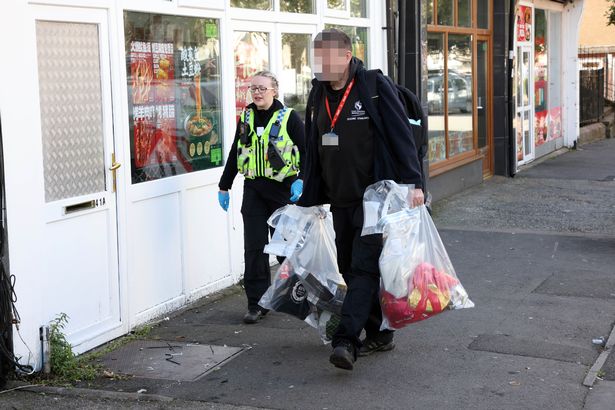 Illegal nicotine products seized in Swansea following a raid involving police, Trading Standards officers, and UK Government officers(Image: walesonline)
Illegal nicotine products seized in Swansea following a raid involving police, Trading Standards officers, and UK Government officers(Image: walesonline)
Research by the University of Bath states opposition to the generational ban was rooted in “claims that it lacked evidence, would fuel the black market, harm retailers, and potentially lead to violence against shopkeepers”.
These are the kinds of arguments used by tobacco lobbyists but they allude to a scenario Roger is certain will not materialise.
He explained: “The tobacco industry will argue that putting prices up is the green light to fuelling the illicit market but the evidence points to the exact opposite.
“Those areas in the world where tobacco is the cheapest actually have the highest market shares of illicit tobacco because there is no regulation enforcement and corruption levels are really high.
“The UK ought to have extremely high levels of illicit tobacco based upon that argument but it doesn’t because the UK has one of the highest prices for tobacco in the world.”
Surprising figures from HMRC back this up perfectly. The data is collected by calculating the duty gaps for cigarettes and hand-rolling tobacco.
Contrary to industry claims the UK’s illicit market has fallen by almost 90% since the turn of the century while the price of an average pack of cigarettes has more than tripled, according to Ash and HMRC.
Another huge concern about this misconception is the apparent rise in racist discourse around the issue of selling illegal smoking products.
As Roger said: “We put a press release out a couple of weeks ago off the back of a couple of closure orders and it went into local news.
“Previously we’d have gotten comments like: ‘Bloody Trading Standards, where am I going to get my cheap fags from now?’ or: ‘I’m sick of these shops selling cheap fags’.
“On this occasion 100% of the comments were nasty and they were racist and identifying the sale of illicit product with migrant communities. I’d not seen that before and that was disturbing.
“It bothered me thinking: ‘How do we publicise this without fueling that kind of reaction?’
“We have an environment now that is significantly different to five or 10 years ago. If we then start talking about illicit tobacco and people start bigging it up as a growing problem and an out-of-control problem it’s adding more fuel to the fire.
“Without a shadow of doubt if you have a largely white community there will be white people involved.
“We deal with people who are very local, generations going back, who are dealing illicit tobacco. It is not the sole preserve of migrant communities – certainly in my personal experience it is across the board.”
WalesOnline approached the Tobacco Manufacturers’ Association for comment but received no response.
All smokers in Wales can receive free non-judgemental support to quit including free stop smoking medication. Visit https://www.helpmequit.wales/ or call 0800 085 2219.

